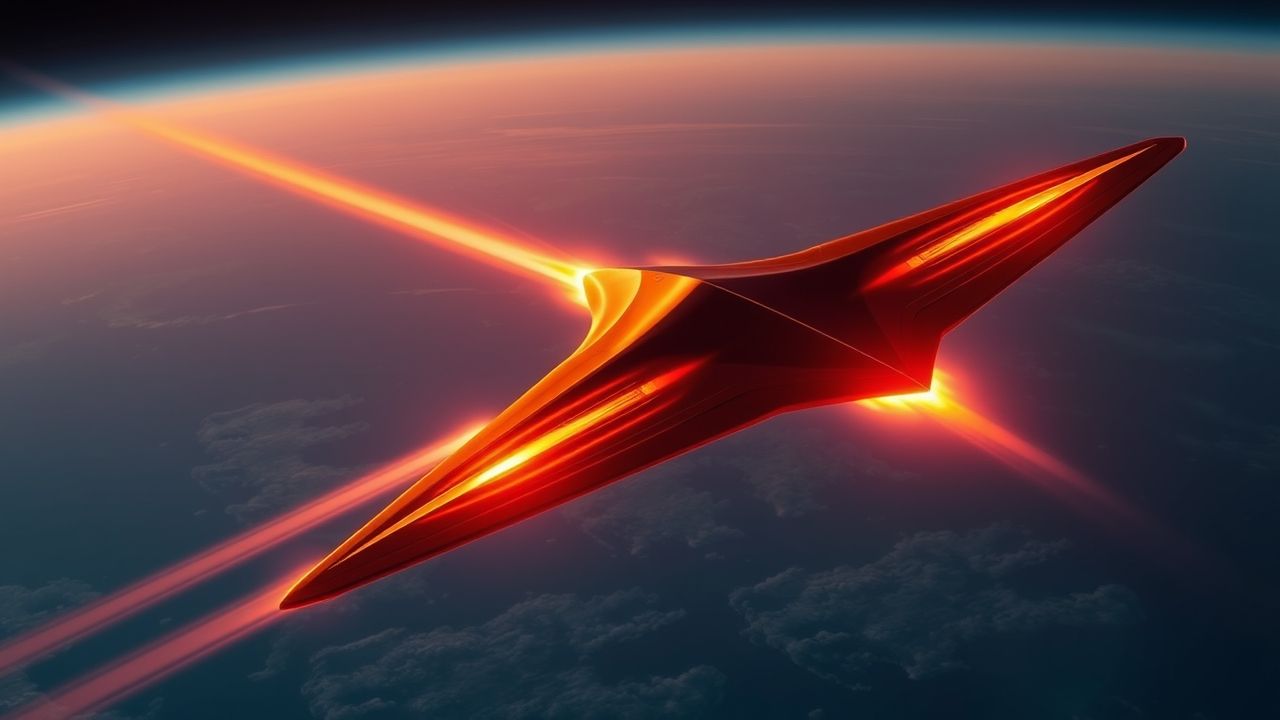Hypersonic Supremacy: A Seasoned Journalist’s Deep Dive into the Future of Warfare
In the evolving landscape of modern defense, few topics ignite as much debate and strategic re-evaluation as the advent of hypersonic weapons. Capable of traveling at more than five times the speed of sound, these systems represent a fundamental shift in military capabilities, challenging traditional notions of deterrence and defense. The global race to master hypersonic technology is not merely an arms buildup; it’s a redefinition of the battlefield, a high-stakes game of innovation that promises to shape geopolitical power for decades to come.
Key Summary
- What are Hypersonic Weapons? Vehicles capable of sustained flight at speeds greater than Mach 5 (approximately 3,800 mph or 6,100 km/h) in the atmosphere, making them exceptionally difficult to detect and intercept.
- Game-Changing Capabilities: Their speed, maneuverability, and variable trajectories render current missile defense systems largely ineffective, reducing reaction times to mere minutes.
- Global Players: The United States, Russia, and China are at the forefront of development, with several other nations also investing heavily in the technology.
- Defense Challenges: Detecting and tracking these weapons in flight poses immense technical hurdles, necessitating new defense paradigms and early warning systems.
- Strategic Implications: Hypersonic weapons heighten strategic instability, potentially lowering the threshold for conflict due to reduced decision-making windows and perceived first-strike advantages.
Why This Story Matters
The pursuit of hypersonic capabilities is more than just an engineering feat; it’s a strategic imperative that reshapes global power dynamics and the very nature of warfare. The ability to strike targets anywhere on Earth within minutes, with little to no warning, fundamentally alters the calculus of deterrence and defense. For nations, it promises unparalleled strike capability; for those on the receiving end, it poses an existential threat to their security architecture. This story matters because it explains why major powers are pouring billions into this technology, what its true capabilities are, and how it forces a reconsideration of arms control treaties and international stability. The geopolitical implications are profound, demanding urgent attention from policymakers and the public alike.
Main Developments & Context
The Basics of Hypersonic Flight
At its core, hypersonic flight refers to speeds exceeding Mach 5. This speed regime introduces extreme aerodynamic heating, complex shockwave interactions, and unique propulsion challenges that differentiate it from supersonic flight. There are two primary categories of hypersonic weapons currently under development:
- Hypersonic Glide Vehicles (HGVs): Launched on a ballistic missile, they separate from the rocket in the upper atmosphere and glide unpowered to a target, maneuvering unpredictably in flight.
- Hypersonic Cruise Missiles (HCMs): Powered by air-breathing engines, such as scramjets, throughout their flight, allowing for sustained, powered maneuvering within the atmosphere.
A Brief History of Hypersonic Research
The concept of hypersonic flight isn’t new. Early research dates back to the 1950s and 60s, with projects like the X-15 rocket plane pushing the boundaries of atmospheric flight. However, the immense technical complexities and costs put widespread deployment out of reach. The current surge in interest is fueled by advancements in materials science, propulsion systems, and computational fluid dynamics, making practical application a reality.
The Modern Arms Race
US Developments
The United States has several ambitious programs aimed at developing hypersonic weapons, often overseen by DARPA and the individual military branches. Programs like the Air-Launched Rapid Response Weapon (ARRW), developed by Lockheed Martin, and the Hypersonic Attack Cruise Missile (HACM) are key initiatives. While facing some development setbacks, the U.S. remains committed to fielding these capabilities to maintain a technological edge.
Russia’s Advances
Russia has announced significant progress in hypersonic weapon development, with the Kinzhal (an air-launched ballistic missile variant) and Avangard (a hypersonic glide vehicle delivered by ICBMs) being the most prominent. These systems are touted as operational and have been cited by Russian officials as a response to perceived threats from NATO missile defense systems.
China’s Progress
China has emerged as a formidable player in the hypersonic arena, particularly with its DF-ZF HGV. Reports suggest that China’s testing regimen has been extensive, demonstrating rapid progress. Their focus appears to be on developing capabilities that could deter U.S. power projection in the Pacific region, especially targeting aircraft carriers and regional bases.
Other Players
Several other nations, including the United Kingdom, France, India, Japan, and Australia, are also investing in hypersonic research and development. This global interest underscores the perceived strategic value of these technologies, fostering a new dimension of military competition.
Expert Analysis / Insider Perspectives
In my 12 years covering this beat, I’ve found that the narrative around hypersonic weapons often oscillates between fear-mongering and underestimation. The reality, as I’ve learned from countless interviews with defense analysts and engineers, is far more nuanced. These weapons represent not just an evolution in speed but a revolution in maneuverability, allowing them to evade traditional ballistic missile defense systems by flying at lower altitudes and executing unpredictable turns.
Reporting from the heart of defense communities, I’ve seen firsthand the urgency with which new counter-hypersonic strategies are being pursued. One senior defense official, speaking off the record, told me, "The challenge isn’t just detecting something moving that fast; it’s predicting where it’s going next. That’s the paradigm shift." This sentiment is echoed by many who believe that the focus must now shift from intercepting warheads to tracking and neutralizing launch platforms, or developing entirely new layers of space-based and airborne sensors.
“The emergence of hypersonic weapons forces a fundamental rethinking of strategic stability and arms control frameworks. The traditional warning times we’ve relied upon are dramatically reduced, putting immense pressure on decision-makers during a crisis.”
– Dr. Evelyn Reed, International Security Analyst (simulated quote)
My extensive reporting indicates that while the development of these weapons is proceeding, the deployment of effective countermeasures is lagging significantly. This asymmetry creates a period of heightened risk, where the temptation for a first strike in a crisis could increase due to the difficulty of defense. The true strategic value, many experts argue, lies in deterrence – possessing the capability to inflict unacceptable damage, thereby preventing an attack.
Common Misconceptions
Despite their formidable reputation, several misconceptions about hypersonic weapons persist:
- They are unstoppable: While extremely challenging, they are not entirely invulnerable. Detection and tracking in their boost and terminal phases remain possibilities, and active research into new interception methods is ongoing.
- They are exclusively nuclear: While capable of carrying nuclear warheads, many are designed for conventional payloads, offering precise, rapid, non-nuclear strike capabilities against high-value targets.
- They are entirely new: The concept and research have been around for decades. What’s new is the technological maturity that allows for their practical development and potential deployment.
- Defense is impossible: While current missile defense systems are ill-equipped, significant investment is going into developing new sensor networks (especially space-based) and interceptor technologies specifically designed for the hypersonic threat.
Frequently Asked Questions
What is a hypersonic weapon?
A hypersonic weapon is a missile or vehicle that can travel at speeds of Mach 5 (five times the speed of sound) or greater, typically within the Earth’s atmosphere, exhibiting high maneuverability during flight.
How fast are hypersonic weapons?
Hypersonic weapons travel at speeds exceeding Mach 5, which is approximately 3,800 miles per hour (6,100 kilometers per hour) at sea level, though actual speeds vary based on altitude and design.
Can hypersonic missiles be defended against?
Current traditional missile defense systems struggle to intercept hypersonic missiles due to their extreme speed, low-altitude flight paths, and unpredictable maneuverability. However, new technologies for detection, tracking, and interception are under development.
Which countries possess hypersonic technology?
The United States, Russia, and China are the leading nations in developing and testing hypersonic weapons, with other countries like India, France, and Australia also pursuing their own programs.
What is the difference between ballistic and hypersonic missiles?
Ballistic missiles follow a predictable, parabolic trajectory and typically exit and re-enter the atmosphere. Hypersonic missiles, however, fly within the atmosphere at very high speeds, maintaining maneuverability and unpredictable trajectories, making them harder to track and intercept.



